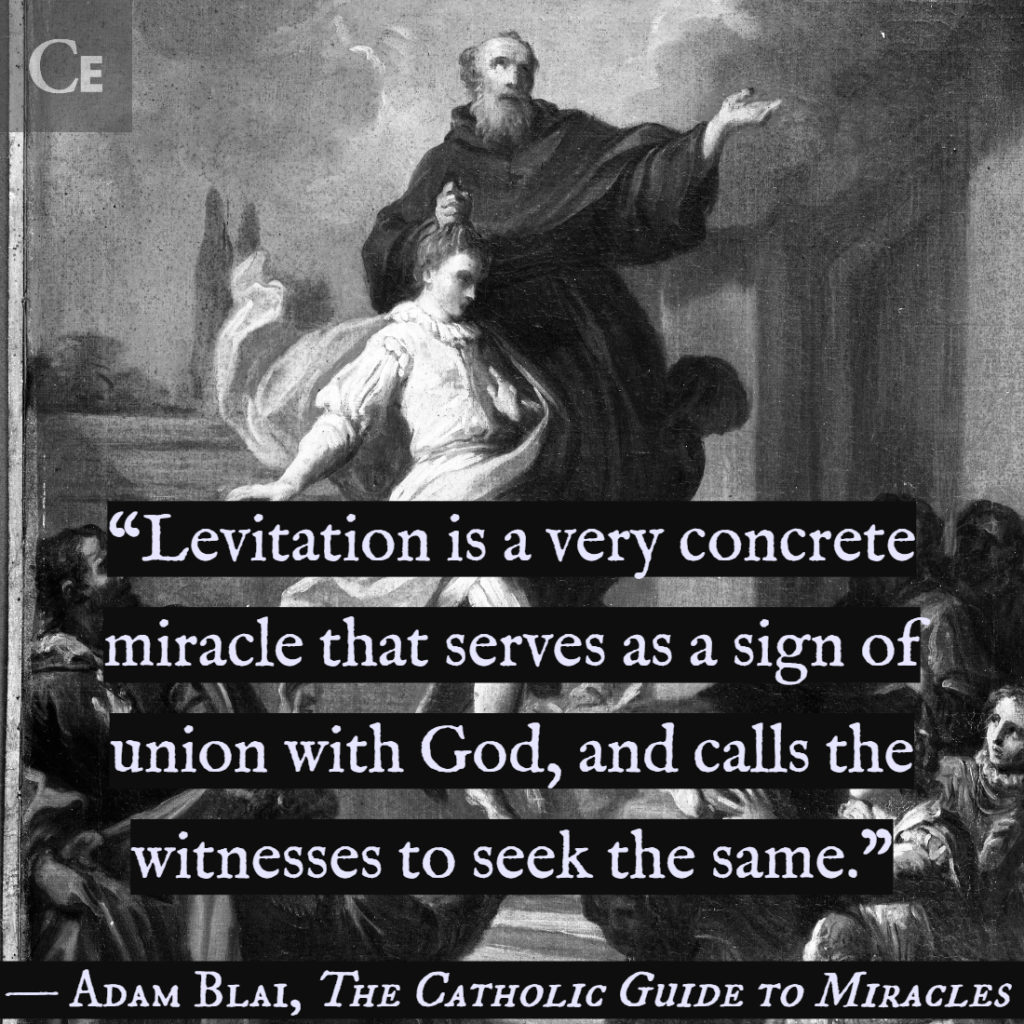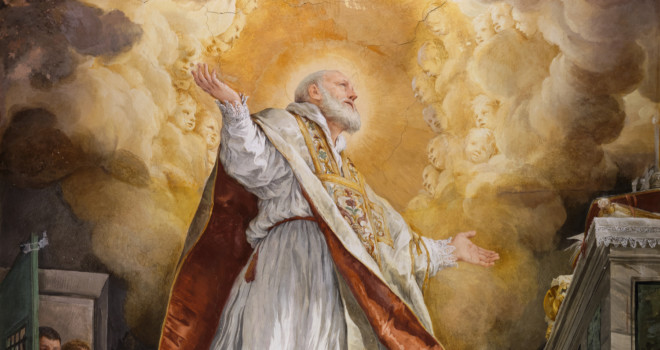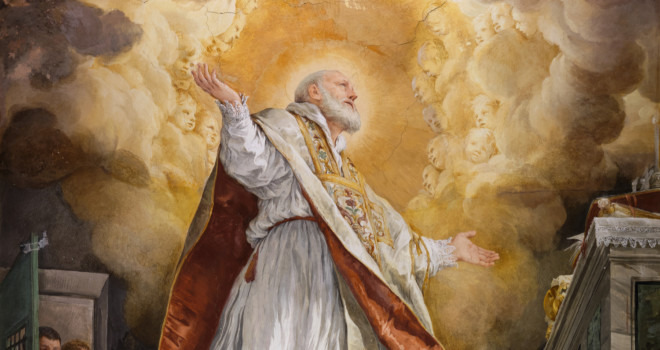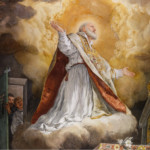Carl Sagan once said, “Extraordinary claims require extraordinary evidence.” Levitation is an extraordinary claim, to be sure. It is also a claim that is very concrete: it is something anyone can observe readily if it occurs. But unlike incorruption, its effects are not lasting, so we have to rely on eyewitness accounts.
As with all claims of the miraculous, the Church has been on guard against exaggeration or fabrication. Having direct testimony from the person who levitated, or from those who witnessed the person levitating, is very important — and even then, the Church keenly examines the reliability and motivations of witnesses. An example of this kind of investigation can be found in claims about St. Francis of Assisi.
Did St. Francis of Assisi Levitate?
St. Bonaventure was born in 1221, five years before Francis died. He entered the Order of Friars Minor (the Franciscans) and became the order’s seventh leader. While mostly known as a philosopher, Bonaventure also wrote about his order’s founder, including the claim that St. Francis was often found floating in the air during spiritual ecstasies. Reports from later writers echoed and expanded on these claims, saying that St. Francis would soar to the treetops and sometimes into the sky, where he could barely be seen.
The difficulty is that in 1245 (nineteen years after he had died), a detailed investigation into Francis’s life had been made by the Church. Authorities interviewed many people who knew him, and none of them mentioned levitation. So, either St. Bonaventure had access to materials that have not survived, or the stories of levitation were an invention that Bonaventure heard and repeated as fact. We are often led to believe that people before the modern era, especially in the Church, were easily duped or indifferent to facts, but the Church has, throughout her history, applied the best methods available to her to get at the truth of miracles.
Rarely were the development of these claims due to deception: rather, pious writers passed on stories that emerged from those devoted to the saints. Given this pattern, should we dismiss all claims of levitation in the lives of the saints? No, it seems not.

St. Teresa of Ávila
There is good reason to believe that St. Teresa of Ávila levitated on a number of occasions. Her levitations were witnessed repeatedly by many people. We also have the saint’s own accounts: she described the experience in her autobiography. Although she preferred not to discuss such matters, she wrote the book under obedience to her superior. Here she describes how she resisted these raptures that sometimes led to levitation:
These effects are very striking. One of them is the manifestation of the Lord’s mighty power: as we are unable to resist His Majesty’s will, either in soul or in body, and are not our own masters, we realize that, however irksome this truth may be, there is One stronger than ourselves, and that these favours are bestowed by Him, and that we, of ourselves, can do absolutely nothing. This imprints in us great humility. Indeed, I confess that in me it produced great fear — at first a terrible fear. One sees one’s body being lifted up from the ground; and although the spirit draws it after itself, and if no resistance is offered does so very gently, one does not lose consciousness — at least, I myself have had sufficient to enable me to realize that I was being lifted up. The majesty of Him Who can do this is manifested in such a way that the hair stands on end, and there is produced a great fear of offending so great a God, but a fear overpowered by the deepest love, newly enkindled, for One Who, as we see, has so deep a love for so loathsome a worm that He seems not to be satisfied by literally drawing the soul to Himself, but will also have the body, mortal though it is, and befouled as is its clay by all the offenses it has committed.
The Life of Teresa of Jesus: The Autobiography of Teresa of Ávila, trans. and ed. E. Allison Peers, from the critical edition of P. Silverio de Santa Teresa, C.D.,
Bishop Diego de Yepes knew her well and wrote one of her many early biographies. One time, after receiving Communion from him through the grille at the convent, she started to rise. The bishop recorded her pleas as she clutched at the bars to stop her ascent:
Lord, for a thing of so little consequence as is my being bereft of this favour of Thine, do not permit a creature so vile as I am to be taken for a holy woman.
Fray Diego de Yepes, Vida de Santa Teresa de Jesus (Toledo, 1530).
There are similar anecdotes told by nuns who saw St. Teresa spontaneously levitate. After the events, she would order them to never to speak of it, but later, under obedience to higher authorities during the Church’s investigation into her life, they described the incidents. For her part, St. Teresa was greatly embarrassed by her levitations and prayed that they would stop, and by all accounts they decreased greatly in her later life.
St. Joseph of Cupertino
Perhaps the most famous levitating saint is Joseph of Cupertino (1603–1663). Joseph had a very difficult childhood. Today he probably would have been diagnosed with a psychiatric disorder of some kind. He was apparently not intelligent and was given the nickname “the open mouth” because he so often stared into space with his mouth agape. Meanwhile, perhaps due to his limitations and others’ response to them, he developed a bad temper. To make matters worse, his father died when Joseph was quite young, and his mother may have been abusive toward him.
Joseph wanted to join the Franciscans, but due to his lack of education, they would not take him. He was then accepted by the Capuchins on a trial basis, but they sent him away after eight months. His mother did not want him back home, so she asked her brother, a Franciscan monk, to take him as a servant at his monastery. Her brother agreed and assigned Joseph to care for livestock. Over time, Joseph’s temper mellowed, and he started doing better with his work — well enough for the Franciscans to allow him to study to become a priest. He was ordained in 1628.
After his ordination, Joseph undertook many penances, including rigorous fasting, usually eating solid food only twice per week. Then he started going into spiritual ecstasies when he said Mass or looked at devotional statues. During these ecstasies, he often levitated a few inches to a few feet off the ground. His levitations were so frequent that people started coming to see him for entertainment; during the investigation of his cause for sainthood, authorities corroborated at least seventy occasions when he levitated in the presence of witnesses.
One notable example happened during a visit to Italy from the Spanish ambassador. The ambassador had visited Joseph in his monastic cell and was so impressed that he wanted to return with his wife. Joseph entered the church where the couple hoped to meet him and, upon seeing a statue of Mary, elevated ten feet into the air, flew over the crowd to the statue, prayed, flew back to the door, and returned home. The Church later took depositions from a number of people who were there that day, and their stories were consistent.
There were many other instances that were investigated in a similar way, including one in front of Pope Urban VIII. It was customary to kiss the pope’s feet at the time, as a sign of homage to the Holy Father. When Joseph did so, he rose into the air and was able to come back down only when his superior ordered him to do so. Pope Urban VIII said that if Joseph died during the pope’s lifetime, he would testify to the levitation that happened in his presence.
After a time, Joseph’s levitations became a problem for the monastery. Some thought the episodes were demonic, and he was denounced for witchcraft and investigated by the Inquisition. They sent him to a monastery in Assisi for observation. He was ordered not to say public Masses and to cease public appearances altogether. But his levitations continued in the monastery, and he was soon relegated to his cell and not even allowed to eat with the other friars. Joseph used this isolation to draw closer to God in prayer. Eventually the inquisition determined that he was not practicing witchcraft and let him return to regular monastic life. Joseph of Cupertino died in 1663 at the age of sixty and was canonized in 1767 by Pope Clement XIII.
St. Mary of Jesus Crucified (Mariam Baouardy)
A more recent example of levitation is St. Mary of Jesus Crucified (1846–1878), who was canonized on May 17, 2015, by Pope Francis. Her life story was covered in the chapter on healings.
On June 22, 1873, the saint was missing at supper, and her fellow nuns went looking for her. They found her balanced on top of a large lime tree, singing. The mistress of novices ordered her to come down without hurting herself, and she complied immediately, lighting touching branches with her feet as she floated gently to the ground. The nuns documented seven more occasions when she levitated. As usual in these cases, some suspected her of trickery, so they spied on and watched her, but no natural explanation could be discovered.
Later a nun testified of the lime-tree incident, “She had taken hold of the tip of a little branch that a bird would have bent; and from there, in an instant, she had been lifted on high.” A priest wrote to the local bishop about the levitations:
Sister Mary used to raise herself to the top of the trees by the tips of the branches: she would take her scapular in one hand, and with the other the end of a small branch next to the leaves, and after a few moments she would glide along the outside edge of the tree to its top. Once up there, she would remain holding on to branches normally too weak to bear a person of her weight.
Amedee Brunot, Mariam, the Little Arab: Sister Mary of Jesus Crucified (1846–1878) (Eugene, OR: Carmel of Maria Regina, 1984).
Conclusions
There’s a wonderful innocence, even childlikeness, in the stories of Sr. Mary’s levitations. She would casually swing from branch to branch, all while singing of God’s love. By the end of her life, witnesses reliably attested to eight such episodes, all in the courtyard of her monastery. We can see how a simple, faithful love of God can sometimes cause us to overcome our limitations. Usually this happens interiorly through the conversion of our souls by grace, but sometimes, in extraordinary circumstances, it can happen outwardly through our bodies.
What purpose might God have in causing some ecstatics to levitate during prayer or praise of God? These levitations may prefigure the rising of the living at the second coming of Christ, detailed in 1 Thessalonians:
For the Lord himself, with a word of command, with the voice of an archangel and with the trumpet of God, will come down from heaven, and the dead in Christ will rise first. Then we who are alive, who are left, will be caught up together with them in the clouds to meet the Lord in the air. Thus we shall always be with the Lord. (1 Thess. 4:16–17)
One could also see levitation as symbolic of rising above the corrupted world, rising above sin when entering a profound contemplation of God that pulls the spirit heavenward. Levitation is a very concrete miracle that serves as a sign of union with God, and calls the witnesses to seek the same.
✠
Editor’s note: This article is adapted from the opening chapter in Mr. Blai’s upcoming book, The Catholic Guide to Miracles: Separating the Authentic from the Counterfeit. It is scheduled to be released on May 25th and can be preordered at your favorite bookseller or online through Sophia Institute Press.
image: St. Philip Neri in levitation, fresco by unknown (1600 ca.) from Chiesa Nuova, (Rome) / Polvo2020 / Shutterstock.com














